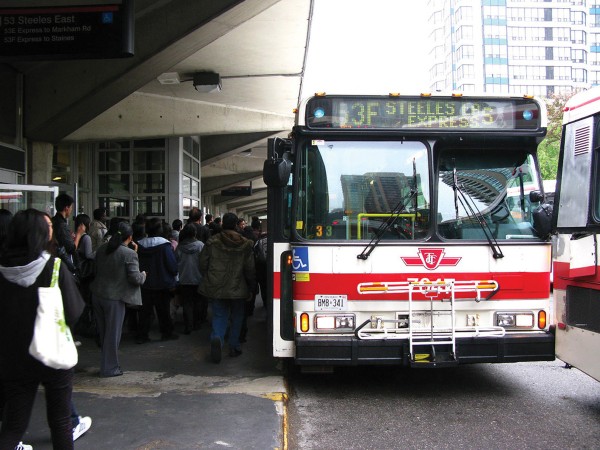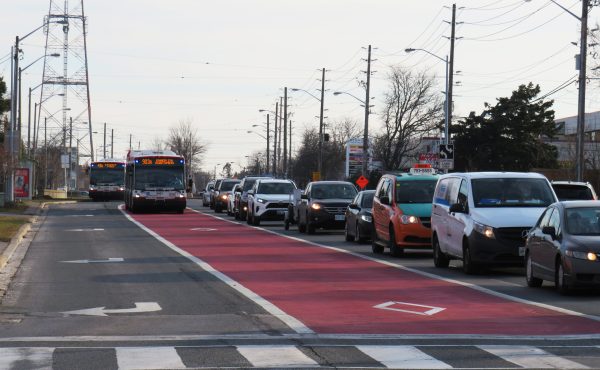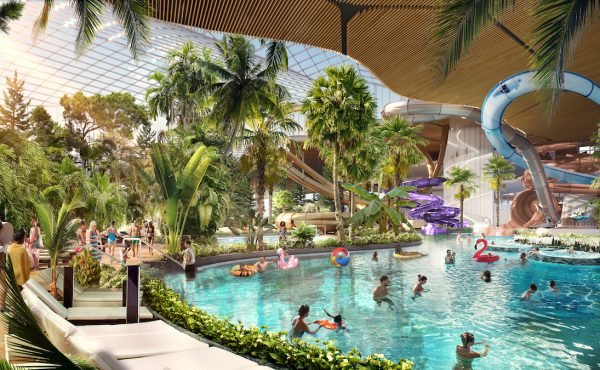Toronto’s intense debate about transit and mobility has focused on access, cost and travel speed. Another important issue, one that’s often left out of the conversation, is greenhouse gas emissions. All motorized trips have environmental impacts – all motorized trips, as well as the construction and maintenance of transit infrastructure (roads and highways, subway tunnels, streetcar tracks), add greenhouse gases to the atmosphere. How far we travel, how we do it (car, bus, subway, bike, etc), and what we build to facilitate travel all bring some degree of greenhouse gas emissions and, by extension, impact on global climate change.
Why is this of importance to the ongoing transit debate? The type of infrastructure that gets built will strongly influence the types of travel choices people make and the emissions associated with each trip. For instance, where walking or cycling are options, trips can be made without any greenhouse gas emissions, but getting more people onto bikes will require more bike routes and a change in tone on cycling policy. For powered trips, public transit is generally much “greener” than private transit, like cars or motorcycles. A bus is greener than car travel as long as the bus route averages an occupancy of six; in other words, as long as there are at least six passengers on every bus, those passengers are contributing less carbon to the atmosphere than drivers in private vehicles. Streetcars, light rail, and the subway need to average only a few people per carriage to emit fewer greenhouse gases per passenger kilometer travelled than cars.
However, people can’t choose public transit unless we build it, especially in parts of the city that are underserved or over capacity. The trade off is that building anything results in greenhouse gas emissions through material use and the energy required in construction. To make real progress towards reducing greenhouse gas emissions the transit infrastructure built should facilitate transit usage in a way that rapidly pays back the initial greenhouse gas emissions invested.
In 2007, Toronto City Council unanimously adopted greenhouse gas reduction targets for the city. Council committed to reducing the city’s emissions by 80% from 1990 (PDF) levels by 2050. Interim targets of 6% by 2012, and 20% by 2020 were also set at the time.
For Toronto to meet these goals, we will have to cut our growing transportation emissions while also keeping in mind the greenhouse gas impact of building new infrastructure. From 1990 to 2011, the city’s total greenhouse gas emissions from power, transport and waste decreased by 15%, despite transportation emissions increasing by 15%. The impact of the construction industry is not reported in the Toronto inventory, but to give an idea of scale, global cement production alone accounts for 5% of all anthropogenic greenhouse gas emissions.
Transport emissions are increasing for a number of reasons: The city is growing, more people means more trips; these trips are also getting longer, annual average travel distance is Canada (PDF) is increasing, often in larger cars (there are more SUVs on the road). Transportation is making up a growing slice of the emissions pie, now accounting for 36% of total emissions, up from 27% in 1990. It could appear that this doesn’t matter given the overall improvement in greenhouse gas output, but a large part of the progress made so far comes from the closing of Ontario’s coal plants, which resulted in much cleaner electricity for Toronto. The electricity supply mix in Ontario is now relatively green (PDF) and will be hard to make much greener over the coming decades. Further emission reductions will need to come from other sectors.
Part of the debate in Toronto centers on what should be built where, with a popular preference for subway over other forms of transit like bus routes or light rail. Subways, built underground with tunnels and intricate stations, require ten times more material than does transit built on the surface. This means that to pay back the greenhouse gas emissions associated with building a subway, the ridership has to be much higher than for a bus or light rail system. An underused system still needs to be lit, staffed, and powered resulting in many greenhouse gas emission despite its low ridership.
One great advantage in Toronto is the availability of very clean electricity. From 1990 to 2011, the greenhouse gas intensity of electricity reduced by 26%. For comparison, electricity in Toronto is three times cleaner than electricity in London and twice as clean as in New York (PDF). In the greenhouse gas race, this gives a big leg up to any system run on electricity: subways, light rail, electric buses and even electric cars.
Toronto has numerous pressing reasons to get aggressive on the transit file, many of which have been discussed ad nauseam over the past four years. The greenhouse gas impact of transport and infrastructure has been mostly lost from the conversation. The city has a commitment to live up to. Given the long life span of infrastructure, decisions made now will continue to impact Toronto’s environmental footprint far into the future.
Shoshanna Saxe is an engineer and a PhD candidate at the University of Cambridge. Say hello on twitter @shoshannasaxe





3 comments
GHG emissions are also very relevant to the island airport debate. Intercity buses, and to a lesser extent high-speed rail, have a carbon footprint lower than Porter’s short-haul flights. Let’s put aside the question of jets. We should be subsidizing environmentally friendly ‘ground’ transportation, not Porter’s planet-damaging planes.
Michael Black: Air Canada and WestJet’s jets from Pearson normally operate at a higher fuel burn per seat than an AC or Porter turboprop from the island (CSeries performance remains to be seen, but just pointing out the current position).
The notion of Toronto electricity being clean, supplied as it is from nuclear facilities, would be controversial to some.
The reality is though that the people of this city don’t give a stuff about GHGs if doing anything about it raises their taxes. We have elected a mayor that has already signalled that projects like taking down the eastern Gardiner are off the table if driving commuters are inconvenienced thereby, succeeding one who garnered a shocking number of votes on the sole issue of $60/year in a car tax. This is exacerbated by being far enough inland that most probably discount sea level rise as something Toronto need be concerned by, unlike coastal metros.
There’s some excellent material in here; but also some clunkers, perhaps from being newer to it all ie. it’s been closer to forty years of discussions/knowing about what to do, not just the last 4/Ford years, and besides – the Council could/did outvote him, so it is wrong to simply blame Ford.
Kudos for bringing back into some public scrutiny the Bold Strivings of great reductions – and also to get a sense that we kinda lie about what our emissions profile is ie. nope, nothing on construction industry contributions ie. we don’t use any cement, brick or glass do we? And it’s very good to have a more detailed analysis of the materials/energy costs of varied transit modes – but our EAs don’t even bother to measure CO2 at all, so that’s where further pressure/action is or should be.
That 1992 study that found Bloor the #1 best for an east-west bike route was a pretty direct outcome of the Toronto Target, and when we rebuilt Bloor St. in both Yorkvile and then west of Bathurst, nothing for bikes beyond smoother road, which can be great, for sure. The Yorkvile Fail should be hung on Miller and Kyle Rae; and the failure to do anything for bikes more recently on Bloor especially west of Ossington where Harbord ends, that’s far more of Ms. Bailao’s doing, and the province looking the other way on the Places to Grow Act. Other Councillors, like Layton, seemed to be averse to “interfering” in Bailao’s turf, and were delighted to rebuild Harbord, which already has a bike lane.
So given that 20 years out, we’re now still – maybe – if we have the money – getting to study the Bloor bike lane and maybe, if it’s scoped right, we can analyze if a bikeway can give transit relief, we’re almost certainly doomed. Sorry….